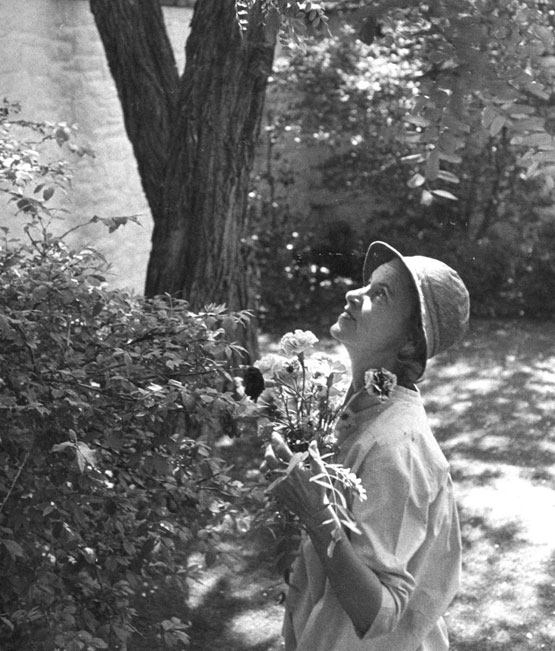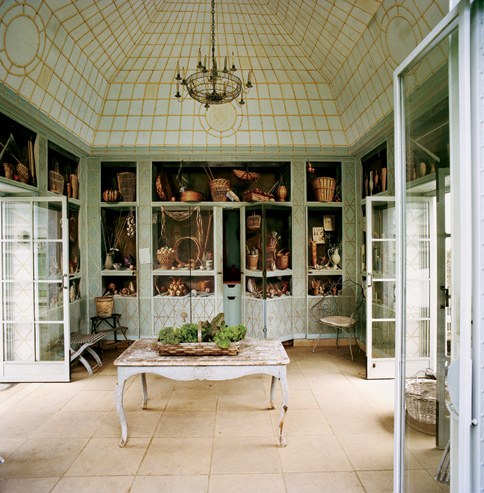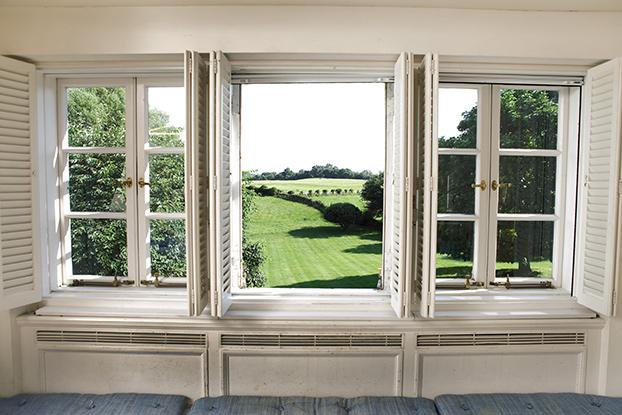Mrs. Mellon's Curious Habit
I’ve just learned the verb “to pleach.”
“Down an arbor of pleached Mary Potter crab-apple trees, behind high stone walls, is a truly enchanted world. Everything is serene, soft, seemingly the essence of artlessness. Yet you quickly realize it is highly controlled—every detail is the result of meticulous labor.” -James Reginato, Vanity Fair, July 30, 2010
Mr. Reginato is talking about the iconic gardens of the incomparable Bunny Mellon, neé Rachel Lowe Lambert (1910 - 2014), at her estate, Oak Spring Farms, in Upperville, Virginia. She’d pleached her crab apples, had Bunny. Probably in the early 60’s or thereabouts. Reginato got a rare peek at her home and gardens in 2010, just before her 100th birthday. And he knew the crab apples were pleached.
I’ve written briefly about Bunny and her passion for horticulture. In particular, I discussed Bunny’s love of topiary, but topiary is truly only a fraction her genius. Bunny Mellon was a giant of a woman, housed in an understated, designer clad, very thin, and very rich body.
Bunny wasn’t particularly pretty. She wasn’t particularly good at being famous. She wasn’t formally educated past the Foxcroft School in Middleburg, Virginia. What Bunny was, was passionate. Obsessed. Driven. Bunny Mellon was in love. Yes, presumably with Paul, banking heir, art collector, horse breeder extraordinaire, and doting husband of 51 years. But, certainly, she was head-over-heels for horticulture.



The Lambert family gardens were the work of the Olmsted brothers of Boston, who went on to design a number of noteworthy gardens, including the spectacular specimen on display at The Biltmore Estate in Asheville, NC. As a child, Bunny observed the installation of her family’s gardens in Princeton, New Jersey, whereupon she was inspired to take up gardening herself, at the ripe old age of 5. The Olmsteds, it might be said, set a high bar for young Bunny.
A 1982 New York Times article revealed that little Bunny, smitten with the garden, pored over old books of Italian and French gardens, then recreated them “in wooden boxes, incorporating small stone steps, real soil, and tiny topiary trees from sponges, glue, wire, and wood.” A curious habit, indeed.
A woman of exacting standards, Mrs. Mellon once famously proclaimed, “Style is order, and order brings pleasure.” I can’t tell you how that simple, beautiful phrase appeals to the organized nerd in me. But, it’s true, isn’t it? I just never thought to say it that way.
Bunny was afforded, as an heiress to the Listerine fortune (and later wife to Paul Mellon), the rare and precious opportunity of travel, plus membership in elite social circles, in the stead of a formal education. Having personally strolled through the French and Italian gardens she studied as a child, Bunny’s style was decidedly European. She favored the orderly and trimmed gardens of France, preferring vegetable gardens rimmed in boxwood hedges, and defined outdoor spaces.
Courtesy of Vanity Fair
For all her wealth, and travel, and opportunity, Bunny was happiest at home. An introvert and an intellectual, she did not crave limelight. Paul Mellon married her after his first wife’s death, and promptly installed her at Oak Spring Farms, his Virginia thoroughbred estate. Bunny designed and oversaw the maintenance of the extensive gardens at Oak Spring from her perch in the (elegant and orderly) greenhouse. She chose to be an active participant in the evolution of her garden, though convention would have given her permission not to.
“Part of creating is understanding that there is always more to do; nothing is ever completely finished,” she insisted. To her immense credit, Bunny Mellon was no pansy. She did not shy away from the demanding work of maintaining her vast gardens. She felt, in fact, should tragedy befall the Mellon estate, she could do all the maintenance herself, so intimate was she with operations at Oak Spring Farms.
Moreover, her good taste extended to clothes, art, and interior design. She became an unwitting mid-century style icon, known for her unique brand of relaxed sophistication. Bunny was interested in - and insisted on - authenticity. Her own home was a study in affected nonchalance, priceless art propped on a priceless mantel, next to some tchotchke, like a postcard. Likewise, her wardrobe. Refined and understated, Bunny was always turned out but never ostentatious. She preached and lived by her mantra, “Nothing should be noticed.” The 21st century translation is "less is more."





Mrs. Mellon amassed, over her 103 years of life, a library full of rare and valuable books on all things botanical, plus priceless art and objéts d'art collected for her own private pleasure. In fact, an acutal library was built to house her collections near her death in 2014. She amassed, too, a head full of knowledge, talent, and creativity, which she doled out discreetly and with dignity. More impressively, she amassed the respect of renown horticulturists, botanists, landscape architects, and social icons like designer Hubert de Givenchy, and the Kennedys. In fact, she was a friend and confidant of Jacqueline Kennedy, having been introduced through a mutual friend in the late 1950's. President Kennedy later commissioned her to redesign the Rose Garden at The White House. This was her circle: presidents and kings. Bunny was an American aristocrat in a quite literal sense, which is precisely why her commitment to horticulture is so surprising. She needn't have bothered, but she did. Oh, how she bothered.
Bunny Mellon with friend Jacqueline Kennedy Courtesy of the Associated Press
With her remarkable penchant for perfection, it is not surprising, at the end of the day, that Bunny pleached her crab apples. I’d be surprised if she hadn’t. This was a woman of discipline, of standards. She ordered her life and her gardens with a certain affable rigidity. To pleach, by the way, is to “entwine or interlace tree branches to form a hedge or provide cover for an outdoor walkway.” There is work involved there. Planning, and patience. The crab apples, it occurs to me, are not unlike Bunny herself: entwined and interlaced with her one true passion. Pleached, indeed.
At her funeral, the actor Frank Langella eulogized her thusly, “Like the flowers she so loved to tame, she brought me into bloom.” Bunny, he said, ”taught a rough Jersey kid how to listen, dress, never be vulgar, respect all people, be humble, avoid hubris, write thank-you notes, never boast, be curious, and above all, be loyal.” Roxanne Roberts of The Washington Post observed, “She never walked red carpets, never gave self-promoting interviews, never sought the spotlight in any way.”
Hers was the quiet, aristocratic life of the very, very rich, and in Bunny Mellon’s case, the very, very humble.
Curious? Here is an interesting article about Bunny Mellon. A new biography is available here, and here you will find a book on her gardens. The Oak Spring Garden Foundation is offering internships for students interested in horticulture. More information on this and other programs at The Oak Spring Garden Foundation.




























